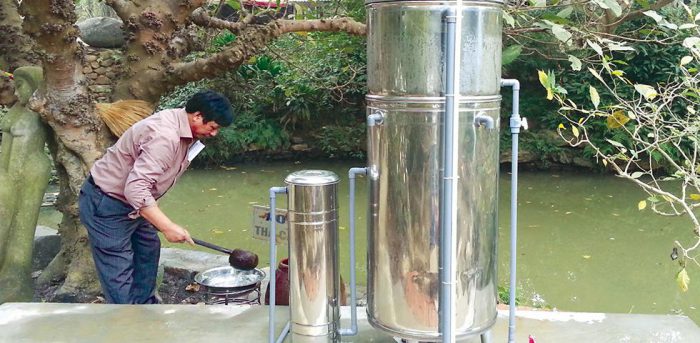Arsenic is an element that is deadly in certain amounts. It would be great to simply say, "Stay away from arsenic", but it's not so easy. This chemical can be found in water supplies in several places around the world, such as rivers and groundwater (water that is found deep underground).
It is possible to filter the arsenic out of the water and make it safe to drink. But these filtering devices are expensive. So especially in poorer places with arsenic in their water (such as Vietnam, Thailand, and Bangladesh), residents are forced to drink contaminated water. People get very sick and even die.
Cheap, easy, and effective
A woman collects contaminated water from the Buriganga River in Bangladesh. Having an inexpensive way to filter water would greatly improve the lives of people in this part of the world. (Getty Embed)
A group of Australian researchers from the University of Technology Sydney (UTS) wants to change all of this. They have invented a new water filtration system that removes arsenic, as well as other pollutants and waste. But unlike other devices out there, it is cheap and uses commonly available parts.
The UTS team worked closely with experts in Vietnam to come up with a filter that would be easy to use. It even uses waste products that would normally be thrown away!
A three-piece system
According to UTS's head researcher, Professor Saravanamuth Vigneswaran, the system has three main parts. There is a membrane, which is a thin "skin" through which the water can pass, but not any solid particles. There is a tank, which stores the water being treated (the water passes through the membrane to get inside the tank). Finally, there is the "absorptive cartridge made from locally available industrial waste products," says Vigneswaran.
The system can be powered by hand, solar, or just gravity. And overall, it costs little to maintain. The cartridges are replaced every three to six months, and membranes can last for three years. In return, clean water is now ready to for drinking and cooking!
Can't put a price on clean water... or jobs
People collect rations of drinking water from a tanker in Dhaka, Bangladesh. More supplies of clean water are needed. (Getty Embed)
Of course, while this system is far cheaper than others out there, it isn't free. Even this can work out in everyone's favour though! The researchers behind the system believe that manufacturing the systems will create needed jobs in areas that are struggling with poverty.
This is still only a prototype. But the UTS team has just received a $500,000 (Australian dollars) prize to continue their research. Nearly 140 million people are exposed to arsenic poisoning in their water, so here's hoping this becomes a reality.
 A man tests out a brand new system to filter arsenic out of drinking water. (University of Technology Sydney)
A man tests out a brand new system to filter arsenic out of drinking water. (University of Technology Sydney)










🙂 🙂 🙂 🙂 🙂 🙂 🙂 🙂 🙂 🙂 🙂 🙂 🙂 🙂 🙂 🙂 🙂 🙂 🙂 🙂 🙂 🙂 🙂 🙂 🙂 🙂 🙂 🙂